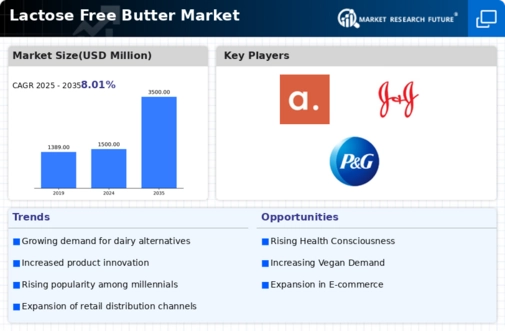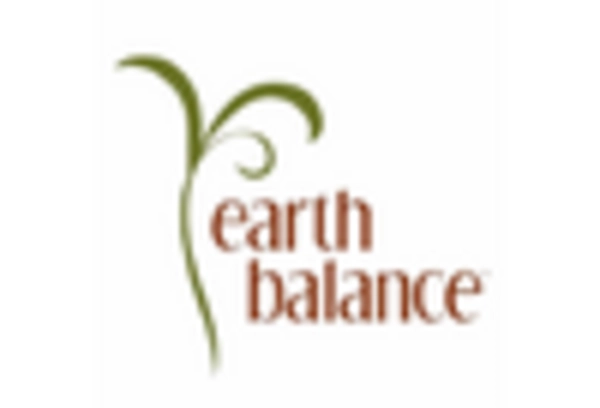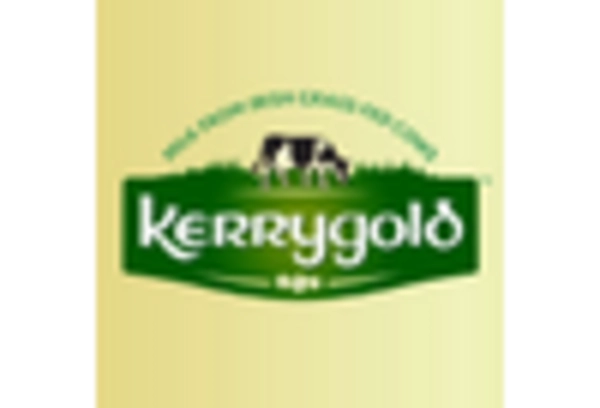Health and Wellness Trends
The ongoing health and wellness trends significantly influence the lactose free-butter market. Consumers are increasingly seeking healthier dietary options, which has led to a rise in the consumption of lactose-free products. The lactose free-butter market benefits from this shift, as many consumers perceive lactose-free options as healthier alternatives. According to recent surveys, nearly 40% of consumers in the US actively seek out lactose-free products, indicating a strong market potential. This trend is further supported by the growing interest in clean-label products, where consumers prefer items with fewer additives and preservatives. As health-conscious consumers continue to prioritize their dietary choices, the lactose free-butter market is likely to expand, driven by the demand for products that align with their health goals.
Increased Retail Availability
The expansion of retail availability is a key driver for the lactose free-butter market. As consumer demand for lactose-free products rises, retailers are increasingly stocking a wider variety of lactose-free options, including butter. This trend is evident in both large supermarket chains and specialty health food stores, which are dedicating more shelf space to lactose-free products. The lactose free-butter market is thus benefiting from enhanced visibility and accessibility, making it easier for consumers to find and purchase these products. Additionally, online grocery shopping has further facilitated access to lactose-free options, allowing consumers to explore a broader range of products from the comfort of their homes. This increased availability is likely to contribute to the growth of the lactose free-butter market, as more consumers are exposed to and encouraged to try these alternatives.
Innovative Product Development
Innovation in product development is a crucial driver for the lactose free-butter market. Manufacturers are increasingly investing in research and development to create new and improved lactose-free butter products that appeal to a broader audience. This includes the introduction of flavored options, organic varieties, and blends that cater to specific dietary needs. The lactose free-butter market is witnessing a surge in creativity, with companies exploring unique ingredients and formulations to enhance taste and texture. For instance, some brands are incorporating plant-based oils to create a more versatile product. This innovation not only attracts lactose-intolerant consumers but also appeals to those seeking healthier, alternative options. As the market evolves, the emphasis on product differentiation is likely to drive growth and consumer interest.
Rising Demand for Dairy Alternatives
The increasing demand for dairy alternatives is a significant factor propelling the lactose free-butter market. As consumers become more aware of the environmental and health impacts of traditional dairy farming, many are turning to lactose-free and plant-based alternatives. The lactose free-butter market is benefiting from this shift, as it offers a viable solution for those looking to reduce their dairy intake without sacrificing flavor. Market data suggests that the dairy alternatives segment is expected to grow at a CAGR of over 10% in the coming years. This trend is indicative of a broader movement towards sustainable eating practices, where consumers prioritize products that align with their values. Consequently, the lactose free-butter market is poised for growth as it aligns with the evolving preferences of environmentally conscious consumers.
Increasing Lactose Intolerance Awareness
The rising awareness of lactose intolerance among consumers is a pivotal driver for the lactose free-butter market. As more individuals recognize their sensitivity to lactose, the demand for lactose-free alternatives has surged. Reports indicate that approximately 65% of the global population experiences some form of lactose intolerance, with a significant portion residing in the US. This growing awareness has led to an increase in product offerings, as manufacturers strive to cater to this demographic. The lactose free-butter market is thus witnessing a shift in consumer preferences, with many opting for lactose-free products to avoid discomfort. This trend is likely to continue, as educational campaigns and health initiatives further inform the public about lactose intolerance, potentially expanding the market's reach and consumer base.

















Leave a Comment